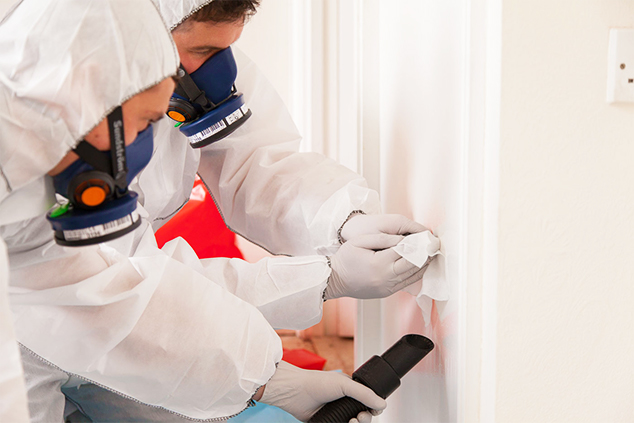Asbestos Regulations – A Beginner’s Guide to The Control of Asbestos Regulations 2012
What is the Control of Asbestos Regulations 2012?
The Health and Safety Executive (HSE) introduced the Control of Asbestos Regulations 2012 (CAR 2012) on 6th April 2012. It came into force to help reduce the number of deaths caused from asbestos exposure and related diseases. The HSE puts the number of asbestos related deaths in the UK at around 5,000 deaths every year.
The regulations, which supersede the Control of Asbestos at Work 2006 regulations, set out the framework for controlling exposure to asbestos and managing asbestos in buildings.
Who Does the Control of Asbestos Regulations Apply to?
The duty to manage asbestos is directed at those who manage or are responsible for maintenance and repairs in a non-domestic building. You classify as a ‘dutyholder’ if you:
- Own the building;
- Are responsible through a contract or tenancy agreement;
- Have control of the building but no formal contract or agreement; or
- In a multi-occupancy building, you are the owner and have taken responsibility for maintenance and repairs for the whole building. However, in a multi-occupied building, the duty can also be shared. The owner might take responsibility for the common parts while the leaseholders take responsibility for the parts they occupy, for example.
If you have information about the premises you are required to co-operate with the dutyholder.
What Premises Do the Regulations Apply to?
The Control of Asbestos Regulations 2012 applies to all non-domestic premises regardless of the nature of business or industry. This includes all industrial, commercial and public buildings such as hospitals and schools as well as factories, offices and shops.
The regulations also apply to ‘common’ areas of certain domestic premises, such as a block of flats. This includes the lifts, foyers, staircases, gardens and so on, but not the individual flats themselves.
What Does the Duty to Manage Asbestos Involve?
The Control of Asbestos Regulations 2012 requires the dutyholder to manage the risk of asbestos by:
- Taking appropriate steps to determine if there are any asbestos containing materials (ACMs) present. If any is found, the amount, location and condition needs to be recorded.
- Presuming that materials contain asbestos unless there is strong evidence to indicate otherwise.
- Producing and maintaining up-to-date records of the location and condition of all ACMs.
- Assessing the risk of the identified materials.
- Preparing a plan that clearly sets out in detail how the risks will be managed.
- Taking the necessary steps to put the plan into action.
- Reviewing and monitoring the plan and arrangements to act on it so that it remains relevant and up-to-date.
- Providing information on the location and condition of the ACMs to anyone who is liable to work on or disturb them.

Why is the Duty to Manage Asbestos Needed?
The purpose of these regulations is to protect those people who may be unknowingly exposed to asbestos fibres during their day to day work, such as plumbers, electricians and decorators. The regulations seek to ensure that the presence of asbestos is not only determined, but also located, recorded and managed as it allows those who come into contact with it to be informed and take suitable precautions.
Asbestos fibres are microscopic and therefore cannot be seen by the naked eye. Symptoms don’t usually tend to become evident until 20+ years after the initial exposure meaning it’s critical that measures are undertaken so that the asbestos can be identified and safely managed. Arranging for an asbestos survey to be carried out by a professional inspection body is the only way to categorically confirm whether the materials in your premises contain the fibrous mineral. Any suspected materials will be sampled and tested in a laboratory to establish just how much asbestos it contains as well as understand the risk it currently poses.
See more: UKAS Accreditation and Asbestos – Everything You Need to Know About UKAS and Asbestos
Things to Remember When Managing Asbestos
- Asbestos is only dangerous when it’s disturbed and becomes airborne. Providing it is in a good condition, is left untouched and is safely managed, it generally doesn’t present a health hazard.
- The duty to manage asbestos is solely about putting in place the practical steps to protect everyone who may work in or visit your premises from the risk of exposure to asbestos fibres. It is not always necessary to actually remove asbestos. If asbestos does need to be removed it needs to be performed by a specialist company licensed by the HSE to undertake removal work. It is illegal for unlicensed and untrained individuals to carry out removal work and anyone doing so may be prosecuted by the HSE or Environmental Health officers.
- Not all ACMs, (Asbestos Containing Materials ), present the same risk. For instance, the measures needing to be taken for controlling the risks of floor tiles containing asbestos will be different to that of boilers containing asbestos.
Asbestos Surveys with Casa Environmental Surveys
If you’d like to arrange for an asbestos survey to be undertaken at your premises, no matter how big or small, please don’t hesitate to get in touch with a member of our team here at Casa Environmental Services today. We are a Type C inspection body accredited by the United Kingdom Accreditation Service to ISO17020 and are able to provide asbestos surveys to premises all over the UK.
Contact us today for a quote >
Asbestos exposure can be fatal so it’s vital that you take the right steps to ensure the risks are adequately managed.
See more: Asbestos in Artex – What You Need to Know About Asbestos in Artex
See more: What Does Asbestos Look Like – The Different Types of Asbestos and Where You Might Find Them




